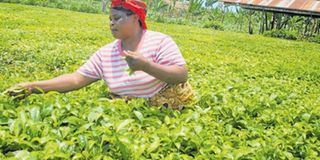Global tea prices decline

A farmer harvests tea. Tea production decreased to 26,975.4 tonnes in Tanzania in the year to June 30, 2017. PHOTO |FILE
What you need to know:
Word commodity price for tea has dwindled, despite an increase in East African exports of the commodity.
Dar es Salaam. Annual world tea prices decreased by 4.4 per cent during the year to September 30, 2018.
The Bank of Tanzania’s economic review for October shows that the average world tea price decreased to $2.95 a kilo during the year to September 30, 2018 compared with $3.09 the previous year.
Prices at the Mombasa Auction fell to $2.62 a kilo from $2.87 during the same period.
At present, there are offerings from Kenya, Uganda, Tanzania, Rwanda, Burundi, Democratic Republic of Congo, Malawi, Madagascar, Zambia and Zimbabwe.
Mombasa auctions attract the UK, Pakistan, Egypt, Afghanistan, Sudan, Iran, Yemen, United Arab Emirates, Ireland, Somalia, Canada and Singapore as major buyers.
According to the Tea Board of Tanzania, production decreased to 26,975.4 tonnes in the year to June 30, 2017 from 32,628.6 tonnes the previous year.
The assistant registrar of Cooperative Societies in Iringa, Mr Robert George, said despite poor weather farmers expanded farms.
It is estimated that in 2016, global production of tea was about 6 million tonnes, led by China with 40 per cent and India with 22 per cent of the world total.
Kenya, Sri Lanka, and Turkey were other major producers. Tea is the most popular manufactured drink consumed in the world, equaling all others – including coffee, chocolate, soft drinks, and alcohol – combined.
Most tea consumed outside East Asia is produced on large plantations in the hilly regions of India and Sri Lanka, and is destined to be sold to large businesses.




